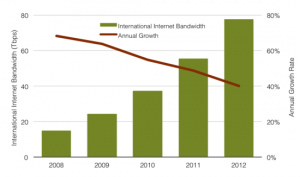We hear so much about the impending flood of mobile data that sometimes it drowns out the real data. Traffic is always growing, but how quickly depends on what part of the network you are looking at. According to Telegeography this morning, international backbone growth slowed down yet again this year even as it reached the 77Tbps mark.
Average international capacity and traffic growth decelerated again this year to 40% and 35%, respectively. It’s downright anemic really when you consider how many carriers are rolling out 100Gbps backbone links these days in order to handle all that traffic caused by evil data hogs and scary unlimited data plans and such.
Of course, it’s at the edge and in the last mile that are seeing traffic really pop. CDNs and transparent caching take care of most of that of course. If one thinks of how many bits actually enter or leave the networks that make up the internet, traffic growth is huge. But more and more traffic travels a much shorter distance than it used to, making average traffic levels at any one spot go up slower than average individual usage.
If we return to the old analogy of the internet as a highway system, it’s as if all the businesses now have local branches, and their employees have a shorter commuting time. So the population may double or triple, yet the highways only see a fraction of that as most of the new arrivals work locally. But the local streets, on the other hand, are full of cars and the investment is just pouring into more and bigger metro roads.
That’s why the metro fiber guys have been recession-proof for so long. I wonder if there isn’t a metric that we could track in parallel to this overall internet traffic growth that would measure the macro growth of the internet’s edge. Probably not, as the edge grows as much by breadth as it does by traffic on particular routes. But still, it might tell an interesting story.
If you haven't already, please take our Reader Survey! Just 3 questions to help us better understand who is reading Telecom Ramblings so we can serve you better!
Categories: Internet Backbones · Internet Traffic







Proliferation of CDNs and caching mechanisms indeed reduces international traffic growth, yet that is a one time effect. Once deployed in the target country, the relative reduction of traffic is constant. Hence, traffic growth onward is purely organic.